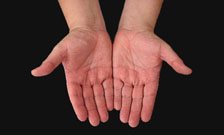
People with the commonest form of motor neuron disease (MND) called amyotrophic lateral sclerosis (ALS) are more likely to have relatively long ring fingers, reveals research from the Institute of Psychiatry (IoP) at King’s.
MND is a serious neurodegenerative disease that results in progressive paralysis and eventual death from respiratory failure. On average, a person survives two years after being diagnosed. The cause of the disease is still mainly unknown, although prenatal factors are thought to be important.
Genetic factors are known to contribute to MND. In both men and women, motor neurons are dependent on testosterone for survival. Men are more likely than women to develop MND and are also exposed to higher levels of testosterone before birth.
The scientists, led by Professor Ammar Al-Chalabi from the IoP, suspected that it was the high prenatal testosterone level rather than male sex itself that was a risk factor for the development of MND in later life, perhaps because this makes the adult motor neurons less sensitive to testosterone.
The researchers looked at the ratio of the lengths of a person’s index finger to ring finger – known as the 2D:4D ratio. This is calculated by dividing the length of the index finger of the right hand by the length of the ring finger.
A low ratio means the ring finger is relatively long compared with the index finger and is thought to be an indicator of high prenatal testosterone levels in men and women (and is probably the reason why on average men have longer ring fingers than index fingers, while women often do not).
The study involved 110 participants with useable results and used a digital camera to photograph hands, finger length was measured and ratios were calculated between fingers.
The 2D:4D ratio was consistently lower for people who had the ALS form of MND compared to those without.
Professor of Al-Chalabi said: ‘This work suggests that even before birth, motor neurons can be affected in ways that make them more vulnerable in later life. Finger lengths seem to be linked to the balance of hormones in the womb, so what we see as a trend towards longer ring fingers is just a marker for the hormone balance during pregnancy. The same trend is seen in sporty people and men, which is why this can never show someone will get motor neuron disease, it is just a clue as to what might be making motor neurons more fragile.’
‘Low index-to-ring finger length ratio in sporadic ALS supports prenatally defined motor neuronal vulnerability’ is published in the Journal of Neurology, Neurosurgery and Psychiatry. http://jnnp.bmj.com/content/82/6/635.full?sid=83b5f70c-b897-4e71-b7c2-b64cbdcd5768
Notes to editors
King's College London
King's College London is one of the top 25 universities in the world (2010 QS international world rankings), The Sunday Times 'University of the Year 2010/11' and the fourth oldest in England. A research-led university based in the heart of London, King's has nearly 23,500 students (of whom more than 9,000 are graduate students) from nearly 140 countries, and some 6,000 employees. King's is in the second phase of a £1 billion redevelopment programme which is transforming its estate.
King's has an outstanding reputation for providing world-class teaching and cutting-edge research. In the 2008 Research Assessment Exercise for British universities, 23 departments were ranked in the top quartile of British universities; over half of our academic staff work in departments that are in the top 10 per cent in the UK in their field and can thus be classed as world leading. The College is in the top seven UK universities for research earnings and has an overall annual income of nearly £450 million.
King's has a particularly distinguished reputation in the humanities, law, the sciences (including a wide range of health areas such as psychiatry, medicine, nursing and dentistry) and social sciences including international affairs. It has played a major role in many of the advances that have shaped modern life, such as the discovery of the structure of DNA and research that led to the development of radio, television, mobile phones and radar. It is the largest centre for the education of healthcare professionals in Europe; no university has more Medical Research Council Centres.
King's College London and Guy's and St Thomas', King's College Hospital and South London and Maudsley NHS Foundation Trusts are part of King's Health Partners. King's Health Partners Academic Health Sciences Centre (AHSC) is a pioneering global collaboration between one of the world's leading research-led universities and three of London's most successful NHS Foundation Trusts, including leading teaching hospitals and comprehensive mental health services. For more information, visit: www.kingshealthpartners.org.
For further information please contact the Institute of Psychiatry Press Office on 0207 848 5377 or iop-pr@kcl.ac.uk
No comments:
Post a Comment